Pasargardae is the site of the first capital of the Achaemenid Empire (). Founded by Cyrus the Great (575-530 BC). The term “Pasargardae” is generally believed to be the Greek phonological derivation of the Old Persian term Pathragada, which may have meant “Camp of the Persians” but this is no longer agreed upon by all specialists of ancient Iranian languages.
The construction of the Pasargardae complex drew upon artisans of not only Iranian origin (Medo-Persian), but also from Anatolia (i.e. Ionia) and Mesopotamia. These arrived at a unique architectural and civil engineering style of synthesis, one that was to herald the construction of the Persopolis city-palace. The synthesis of various artistic, architectural and engineering styles in northern, western and southern Iran however can be dated to the Elamites, the Medes as well as Luristan.
The site of Pasargardae is well known as housing the tomb of Cyrus and is also known as one of the genesis points for the Persian Gardens of old.
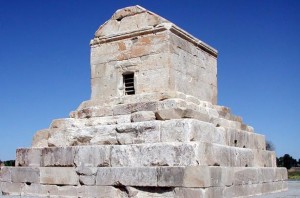 The Tomb of Cyrus at Pasargardae which has been listed as a World Heritage site by UNESCO.
The Tomb of Cyrus at Pasargardae which has been listed as a World Heritage site by UNESCO.
The Tomb of Cyrus: Architecture and Engineering
The design of Cyrus’ tomb is fascinating as it appears to incorporate aspects of both Elamite and Mesopotamian influences. The Elamites had been fusing with the Iranian peoples in south and southwest Iran, especially the Persians (called Parsuash by the Assyrians).
There are three sections of interest in the tomb of Cyrus. The first is an elevated podium 21.9 meters high and whose base is 13.2 x 12.2 meters. Of particular interest is the use of large blocks in the building of the podium and the tomb itself (see description of this on the History Channel program “Engineering an Empire: The Persians“). The blocks were cut very precisely and placed without the use of mortars. Reinforcement was provided by a unique system of clamps or staples.
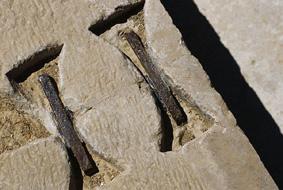 Staples or clamps used to secure the blocks at Pasargardae.
Staples or clamps used to secure the blocks at Pasargardae.
It is very likely that the techniques for masonry at the tomb have significant influences from the Ionians and Lydians. These influences may be explained by Cyrus’ defeat of King Croesus of Lydia (reigned 560 to 546 BC) who was King Alyattes II (619-560 BC) son and successor. Cyrus also conquered the Ionians along the western coast of Anatolai (modern western Turkey). These conquests resulted in the arrival of Ionian and Lydian artisans who bought these particular features to site at Pasargardae.
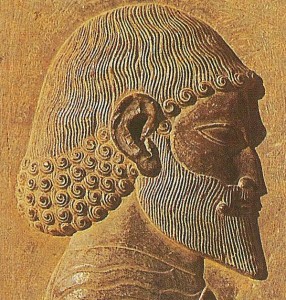
An Ionian as depicted in the city-palace complex at Persepolis
The second section is a small chamber, which appears to have some Urartian influences. Urartu located towards northwest Iran and the Caucasus (roughly where Armenia is today) had already witnessed a symbiotic relationship between its own arts and architecture and those of the Medes, although this is a domain that requires more research and excavation work. The tomb itself has the following measurements: it stands at 2.11 meters in height is also 2.11 meters wide and is 3.17 meters in length. Western researchers have noted that these dimensions resemble those found at the tomb of King Alyattes II (619-560 BC) of Lydia. While this is true, it is possible that the inspiration for this may have been derived from the underground tombs of Luristan that have similar type of roofs. Luristan has been a seminal nexus point for the genesis and synthesis of various forms of artistic, metallurgical and building techniques that were to influence the Iranian plateau and northwest Iran.
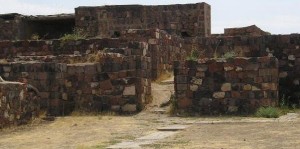 The Erebuni Fortress (Uratian) in modern Yerevan, Armenia.
The Erebuni Fortress (Uratian) in modern Yerevan, Armenia.
The third section of the structure is a roof and could resemble Phrygian type designs from ancient Anatolia.
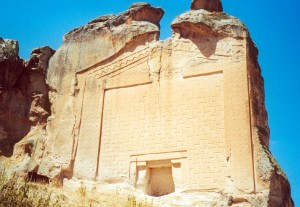 A Phrygian Tomb at Midas City dated the 6th Century BC, near modern Eskishehir, Turkey.
A Phrygian Tomb at Midas City dated the 6th Century BC, near modern Eskishehir, Turkey.
The arrival of Alexander the Great
Alexander the Great (356-323 BC) who conquered the Achaemenid Empire, held a profound sense of admiration and respect for Cyrus the Great. When Alexander arrived at the tomb of Cyrus at Pasargardae, he is described as having paid his respects at the site and also ordered the tomb repaired and its contents restored (i.e. Arrian, XXIX, 1-11; Quintus Curtius, VII, 6.20).
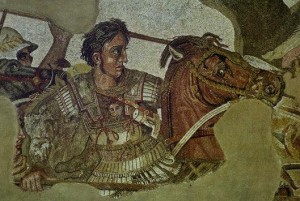 Alexander the Great (356-323 BC) not only spared the Tomb of Cyrus but ordered it to be repaired and restored to its original state.
Alexander the Great (356-323 BC) not only spared the Tomb of Cyrus but ordered it to be repaired and restored to its original state.
It is believed that the items found by Alexander at the site included a carpet (possibly of the Pazyryk type), a golden coffin, bejeweled decorations, a couch with covering (or perhaps quilt of some kind) a table set with drinking goblets (possibly resembling the rhython seen in the photo below).
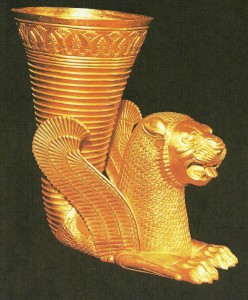
Achaemenid Rhython
This tomb continues to inspire the admiration of western researchers to this day.
The Arabian arrivals
When the Arabs conquered the Sassanian Empire (224-651 AD) and entered Iran they first planned to destroy the tomb of Cyrus at Pasargardae. Legends detail the story of how the locals dissuaded the Arabs from demolishing the site by recounting to them that it actually housed the remains of the mother of Solomon. This explains why the inscription at the site today states “Qabr e Madar e Soleiman”
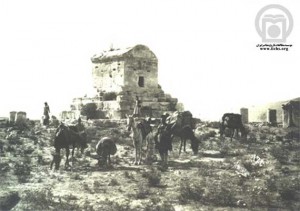 A photograph of Pasargardae in the latter days of the Qajar Dynasty.
A photograph of Pasargardae in the latter days of the Qajar Dynasty.
Recent Controversies, Damages to site and the rise of Cyrus’ advocates inside Iran
There has been much controversy and discussion in recent years as to whether the construction of the dam of Sivand poses dangers to the site. Advocates of the dam state that no dangers exist, however this is not agreed upon by all experts, even in Iran. An organization in Iran known as Omedia has recently indicated that it may implicate the International Criminal Court for “crimes against humanity” due to potential destruction to Cyrus’ tomb.
It is fairly certain that the construction of the dam will generate humidity than can cause damage to the nearby recently discovered palace of Darius the Great (549-486 BC) site of Tang e Bolaghi in the long term.
The issue however is not just whether the Sivand Dam poses a danger to Pasargardae and other heritage sites. In mid November Mehr News of Iran, Payvand news and the Shahrbaraz Blog reported that a part of the stone in the ceiling of Cyrus’ tomb had been removed and replaced with another piece of stone (and possibly mortar – detials await the UNESCO report). This was duly reported by an archaeological expert of ICHTHO (Iranian Cultural Heritage, Tourism and Handicrafts Organization). The expert, who asked to remain anonymous, told reporters that:
“Even natural factors such as wind and storms were not able to cause this kind of damage,”
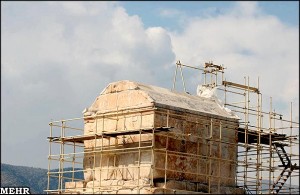
Photo from Mehr News. A portion of the ceiling has been replaced with crude restoration methods not in concordance with proper archaeological techniques.
The actual restoration had been originally entrusted to a team of trained and experienced Italian researchers. Inexplicably however, these had been dismissed two years ago and substituted with an Iranian team (led by Hassan Rahsaz) that has no credible training in archaeological techniques and restoration. The aforementioned ICHTO archaeological expert, who noted that the works by the Rahsaz team is “the kiss of death” further told reporters that:
“Rahsaz has learned restoration from on-the-job experience and he doesn’t have a relevant academic degree…During the project, he made many mistakes, the most important of which is related to the ceiling of the Tomb of the Cyrus the Great…While if the restoration of the ceiling was carried out based on scientific methods, it would have lasted in two years…”
The ICHTO expert noted that restoration of such sites must be done very slowly and meticulously by carefully and patiently repairing each piece of mortar and stone that have been separated from the monument over the centuries. This is in fact in concordance with scientific archaeological techniques.
The ICHTO report however is strongly disputed by Mohammd-Hassan Talebian (the director of the Parsa and Pasargadae Research Foundation – PPRF) who noted that:
“The restoration is one the best of its kind carried out in this country…A report containing details of the restoration project has been sent to UNESCO; if there was problem with the method used for restoration of the monument, they would certainly have notified us of a problem“
It is still difficult It is hard to ascertain how the actual restoration has been done, without access to a complete and very technical report. It is fairly certain that the team did remove priceless pieces of ancient stone and simply replaced these with new ones. Even a UNESCO report would need to be supported and verified by their independent observers before arriving at a final conclusion.
Talebian refers to the fact that the restoration prevents rain from leaking into the chamber. However simply “plugging a leaky roof” is not a measure of archaeological prowess or success. What is certain is that the removed pieces of the stone of the tomb’s roof can certainly fetch a tidy sum in the markets, notably private collectors and enthusiasts.
Nevertheless, the situation in Iran is far from monolithic; in fact as noted already, there are many inside of Iran who work hard to preserve the ancient heritage of Cyrus. The Jaam e Jam News Service of Iran reported on November 24th 2008 that Rahim Mashayekhi, the Head of Iran’s Miraas e Farhangi (Cultural Heritage) delcared that Cyrus Day has now officially entered the national calendar of Iran. This is a clear indication that the advocates of Iran’s ancient heritage are growing in influence inside of Iran.
Controversies aside, one element is for certain: the legacy of Cyrus’ humility endures to this day. An ancient inscription (now lost) is believed by many to have stated the following:
“O man, whoever thou art… I am Cyrus, Grudge me not, therefore, this little earth that covers my body.”
Further readings:
Bussagli, M. (2005). Understanding Architecture. London: I.B.Tauris.
Chahin, M. (1975). Ararat the ancient kingdom of Armenia. History Today, XXV (6), pp. 418-427.
Curtis, J. (1990). Ancient Persia. Boston: Harvard University Press.
Daniel, E.L. (2001). The History of Iran. Greenwood Press.
Ferrier , R.W.(1989) The Arts of Persia. Yale University Press
Moorey, P.R.S. (1974). Ancient Bronzes from Lursitan. London: British Museum.
Stronach, D. (1985). Pasargardae. In I., Gershevitch (Ed.), Cambridge History of Iran: Vol.2 The Median and Achaemenean Periods, Great Britain, Cambridge University Press, pp. 838-855.



